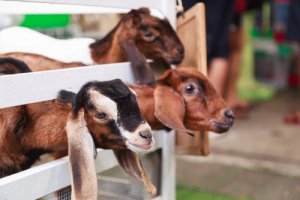Caring for Goats: 4 Things You Need to Know


Written and verified by biochemistry Luz Eduviges Thomas-Romero
Caring for goats can be great fun. Many people buy goats for their milk or because of how effective they can be at pulling up weeds. But these animals also make fantastic pets, and can be endlessly entertaining.
But before you go out and buy a goat, it’s important to know how to keep them happy and healthy. Here are the 4 main things you need to know:
Caring for goats: physiology
Medium to large adult female goats – including Alpine goats, the Cabra Majorera or Fuerteventura goat, the Malagueña, the Murciana, the Palmera, or the Pirenaica – generally weigh between 130 and 176 lbs, while males weigh between 176 and 220 lbs. Smaller breeds such as the Serrana, the Verata, and the Retinta weigh around 100 lbs.
Goats can live between 12 and 14 years.
Female goats can be milked up to twice a day. Goat’s milk is really popular, and different from cow’s milk in texture and composition.

Caring for goats: diet and nutrition
Fresh water
Goats should always have access to clean water, and can drink between 0.5 and 4 gallons a day. Because they are such lively and mischievous animals, it’s best to use heavy water containers so that they can’t knock them over.
Minerals
Minerals are an essential part of a goat’s daily nutrition. If you’re planning on keeping goats and sheep together, it’s important to make sure that the minerals you give them are suitable for both species.
For example, while sheep can’t tolerate large amounts of copper, it is essential for goats. Copper deficiency in goats can lead to a number of health problems. So, if you’re planning on keeping sheep and goats together, you’ll need to give your goats copper supplements separately.
Diet
Goats are ruminants, which means their stomachs have four chambers or compartments. They mainly eat hay or grass, and need to graze for at least 8 hours a day.

The best pastures for goats should include a mixture of clovers and grasses. If your pasture is composed uniquely of fodder crops, be careful not to let them eat too much. Similarly, before letting your goats out into the pasture, be sure to check for toxic plants.
We would recommend getting in contact with your local council to obtain a full list of plants that are toxic to goats.
These ruminants prefer to eat a diet of leaves, plants and brambles. However, it’s important to be aware that ornamental plants such as rhododendron can be fatal to goats.
Cereals are very high in fat, and can cause urinary calculi (or kidney stones) in goats. Females are particularly susceptible. As such, we wouldn’t advise giving them cereals on a regular basis.
However, cereals can be given as a supplement, and are highly recommended for goats with dental issues, or for those that are underweight.
Caring for goats: handling
Keep calm
When it comes to caring for and handling goats, it’s important to act in a calm, relaxed manner. Goats are naturally nervous animals, and can scare easily if you shout at them or handle them roughly.
We would recommend using a halter when handling your goats. If they have horns, you can use these to help control them (although you might find that some animals won’t take too kindly to that).
Provide shelter
Your goats will need a warm, comfortable shelter with a sturdy roof. Earthen floors are best for goats. The shelter should be well-ventilated, without it becoming cold and drafty.
They will also need plenty of clean, dry hay to act as bedding which will need to be changed on a daily basis.
Paddock
As well as a suitable shelter, you’ll also need to provide your goats with a large outdoor area where they can walk around and graze in the fresh air. Ideally, you should use a woven wire fence, roughly 4ft high.

Fences with large gaps pose a serious risk to goats, especially those with horns. It’s all too easy for them to get their heads stuck. Check your fences regularly to make sure there are no holes or broken sections.
Tie-up
It’s best not to tie up your goats as they can quickly become stressed. Furthermore, tying them up with a long rope can be extremely dangerous – they can easily become tangled and, if it gets around their neck, they may even strangle themselves.
Caring for goats: day-to-day care
Caring for goats isn’t too complicated. Keep their enclosure clean, provide them with good quality pasture, nutritious food, and plenty of sunlight, and you’ll be able to drastically reduce the risk of health problems.
It’s also important to have their hooves trimmed every 4-6 weeks. This is essential, as neglecting their hooves can quickly lead to lameness and infection. This is a fairly simple procedure, and your vet can teach you how to do it yourself.
During your daily contact with your goats, it’s important to check for any physical or behavioral changes. Common symptoms of illness include loss of appetite, lameness, apathy, breathing difficulties, diarrhea, discharge from the eyes or nose, and an abnormally high or low body temperature. If you notice any of these symptoms, consult your vet immediately.
Make sure your goats are vaccinated against rabies, tetanus and clostridium (CDT). It’s important to wait at least one month between administering the rabies vaccination and the other vaccinations, to allow the immune system enough time to respond properly.
Caring for goats can be great fun. Many people buy goats for their milk or because of how effective they can be at pulling up weeds. But these animals also make fantastic pets, and can be endlessly entertaining.
But before you go out and buy a goat, it’s important to know how to keep them happy and healthy. Here are the 4 main things you need to know:
Caring for goats: physiology
Medium to large adult female goats – including Alpine goats, the Cabra Majorera or Fuerteventura goat, the Malagueña, the Murciana, the Palmera, or the Pirenaica – generally weigh between 130 and 176 lbs, while males weigh between 176 and 220 lbs. Smaller breeds such as the Serrana, the Verata, and the Retinta weigh around 100 lbs.
Goats can live between 12 and 14 years.
Female goats can be milked up to twice a day. Goat’s milk is really popular, and different from cow’s milk in texture and composition.

Caring for goats: diet and nutrition
Fresh water
Goats should always have access to clean water, and can drink between 0.5 and 4 gallons a day. Because they are such lively and mischievous animals, it’s best to use heavy water containers so that they can’t knock them over.
Minerals
Minerals are an essential part of a goat’s daily nutrition. If you’re planning on keeping goats and sheep together, it’s important to make sure that the minerals you give them are suitable for both species.
For example, while sheep can’t tolerate large amounts of copper, it is essential for goats. Copper deficiency in goats can lead to a number of health problems. So, if you’re planning on keeping sheep and goats together, you’ll need to give your goats copper supplements separately.
Diet
Goats are ruminants, which means their stomachs have four chambers or compartments. They mainly eat hay or grass, and need to graze for at least 8 hours a day.

The best pastures for goats should include a mixture of clovers and grasses. If your pasture is composed uniquely of fodder crops, be careful not to let them eat too much. Similarly, before letting your goats out into the pasture, be sure to check for toxic plants.
We would recommend getting in contact with your local council to obtain a full list of plants that are toxic to goats.
These ruminants prefer to eat a diet of leaves, plants and brambles. However, it’s important to be aware that ornamental plants such as rhododendron can be fatal to goats.
Cereals are very high in fat, and can cause urinary calculi (or kidney stones) in goats. Females are particularly susceptible. As such, we wouldn’t advise giving them cereals on a regular basis.
However, cereals can be given as a supplement, and are highly recommended for goats with dental issues, or for those that are underweight.
Caring for goats: handling
Keep calm
When it comes to caring for and handling goats, it’s important to act in a calm, relaxed manner. Goats are naturally nervous animals, and can scare easily if you shout at them or handle them roughly.
We would recommend using a halter when handling your goats. If they have horns, you can use these to help control them (although you might find that some animals won’t take too kindly to that).
Provide shelter
Your goats will need a warm, comfortable shelter with a sturdy roof. Earthen floors are best for goats. The shelter should be well-ventilated, without it becoming cold and drafty.
They will also need plenty of clean, dry hay to act as bedding which will need to be changed on a daily basis.
Paddock
As well as a suitable shelter, you’ll also need to provide your goats with a large outdoor area where they can walk around and graze in the fresh air. Ideally, you should use a woven wire fence, roughly 4ft high.

Fences with large gaps pose a serious risk to goats, especially those with horns. It’s all too easy for them to get their heads stuck. Check your fences regularly to make sure there are no holes or broken sections.
Tie-up
It’s best not to tie up your goats as they can quickly become stressed. Furthermore, tying them up with a long rope can be extremely dangerous – they can easily become tangled and, if it gets around their neck, they may even strangle themselves.
Caring for goats: day-to-day care
Caring for goats isn’t too complicated. Keep their enclosure clean, provide them with good quality pasture, nutritious food, and plenty of sunlight, and you’ll be able to drastically reduce the risk of health problems.
It’s also important to have their hooves trimmed every 4-6 weeks. This is essential, as neglecting their hooves can quickly lead to lameness and infection. This is a fairly simple procedure, and your vet can teach you how to do it yourself.
During your daily contact with your goats, it’s important to check for any physical or behavioral changes. Common symptoms of illness include loss of appetite, lameness, apathy, breathing difficulties, diarrhea, discharge from the eyes or nose, and an abnormally high or low body temperature. If you notice any of these symptoms, consult your vet immediately.
Make sure your goats are vaccinated against rabies, tetanus and clostridium (CDT). It’s important to wait at least one month between administering the rabies vaccination and the other vaccinations, to allow the immune system enough time to respond properly.
All cited sources were thoroughly reviewed by our team to ensure their quality, reliability, currency, and validity. The bibliography of this article was considered reliable and of academic or scientific accuracy.
- Barroso, F. G. (1988). Estudio sobre el comportamiento alimentario y social de la cabra doméstica en el sureste árido español (Doctoral dissertation, Universidad de Granada).
- Seguí, B., Payeras, L., Ramis, D., Martínez, A., Delgado, J. V., & Quiroz, J. (2005). La cabra salvaje mallorquina: origen, genética, morfología, notas ecológicas e implicaciones taxonómicas. The majorcan wild goat: origin, genetic, morphology, ecological notes and taxonomic implications. Bolletí de la Societat d’Història Natural de les Balears, 48, 121-151.
- Vives, J. A., & Baraza, E. L. E. N. A. (2010). La cabra doméstica asilvestrada (Capra hircus) en Mallorca ¿Una especie a erradicar? Galemys, 22, 193-205.
- Mancilla Leytón, J. M. (2014). El papel de la cabra doméstica (Capra hircus L.) en la estructura y conservación del Monte Mediterráneo. Ecosistemas, 23(2).
- Instituto Nacional de Investigaciones Forestales, Agricolas y Pecuarias (2014) CALENDARIO SANITARIO PARA CAPRINOS EN PASTOREO EN TAMAULIPAS. Recuperado el 30 de junio de 2022, disponible en: http://www.inifapcirne.gob.mx/Eventos/2015/SANITARIO%20CAPRINOS.pdf
This text is provided for informational purposes only and does not replace consultation with a professional. If in doubt, consult your specialist.








